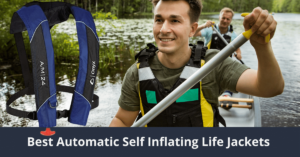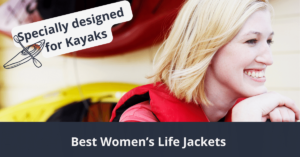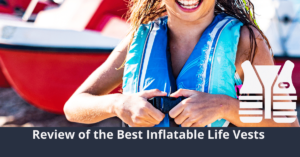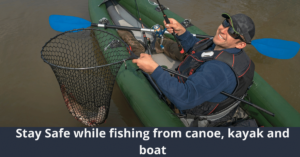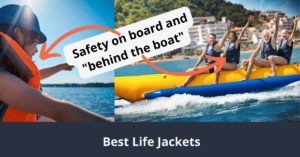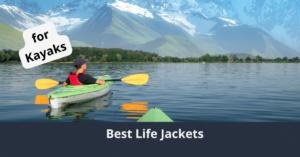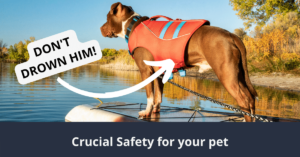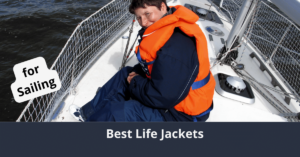You know that wearing a life jacket is essential when you’re playing on or near the water. After all, life jackets aren’t just for kids or those who can’t swim. In an instant, any water activity can become dangerous—so it pays to prepare ahead of time.
But if your body size is above average, it can be a struggle to find a life vest that fits. Fortunately, we’ve rounded up some of the best big and tall life jackets on the market so you can choose one that will help keep you safe and comfortable.
Check out our life vest reviews to find the best option for your budget, lifestyle, and body type. Then, read on for more information on how to choose the right life vest for your needs—including what measurements you’ll need to get a perfect fit. Plus, we’ll cover how to maintain your equipment and what to consider when it comes to water safety, year-round.
[Product table]
Everything you will learn here
The Best Big and Tall Life Jackets Reviews (Top Picks)
Are you looking for the best big and tall life jacket for your next on-the-water excursion? Here are our top picks—in no particular order—with all the features you need.
1. Onyx MoveVent Dynamic Paddle Sports Life Vest
- Mesh in lower back fits high back seats;
- Shoulder adjustments with neoprene comfort pads
- SOLAS grade reflective material for visibility
For water excursions that require ease of movement, Onyx’s MoveVent Dynamic Paddle Sports Life Vest might be the perfect fit. It’s a U.S. Coast Guard-approved Type III PFD. The XL/2XL size accommodates users up to around 300 pounds, and the breathable paneling helps keep you comfortable.
Part of what makes the MoveVent vest a great fit for bigger folks is the adjustability. The sizing ranges from 44 to 56 inches in circumference. Plus, the shoulders are adjustable with neoprene pads for comfort. The shortened front panel allows room for you to breathe, too.
What’s most notable about this vest is the mesh paneling for both breathability and the ability to lean back in your seat on the boat or other watercraft. The unique cut also means you can manage oars or paddles a bit easier than with traditional PFDs.
Pros
- Fits chest sizes 44” to 56”
- Has zippered pockets
- Lower back mesh so you can sit comfortably
- Lightweight and less bulky than alternatives
Cons
- The zipper closure means the adjustability is somewhat limited
- The vest feels a little bulky in the front
- Room to move around can mean a loose fit in the water
2. O’Neill Men’s Reactor USCG Life Vest
- USCG Approved Personal Flotation Device; Perfect for Wake Sports, Waterskiing, Tubing, and Swimming
- Segmented Foam Core And Anatomical Flex Points Allow Unrestricted Movement
- Quick Release Safety Buckles And Heavy Duty Front Zipper Create an Unparalleled Sense of Security
O’Neill’s Reactor life vest addresses sizing needs up to 3XL, fitting wearers with up to a 50-inch chest circumference. A zipper closure plus adjustment straps let you customize the fit, which should be snug due to the neoprene construction.
When this vest gets wet, it will expand, so a close fit is ideal when sizing. At the same time, the built-in expansion panels, adjustable straps, and tapered fit help keep you comfortable. Even when the vest is on tight, it doesn’t feel too restrictive.
Since each vest is rated by the USCG, you can bet it’ll keep you afloat in the event of an emergency. The zipper plus adjustable straps mean you can get a secure fit, whether in or out of the water.
Pros
- Sizes range up to XXXL/50” chest size
- Expansion panels add some maneuverability
- A tapered bottom helps fit around your middle
- The trim fit is ideal for watersports
Cons
- Wrangling the adjustment straps can be a chore
- The material expands when wet, which affects the fit
- It absorbs water, so needs a good wringing out before you store it
- No pockets or clips
3. O’Brien Mex’s Flex V-Back Neoprene
- Neoprene outer for comfortable fit
- Front hinge for movement
- Zip closure and 2 belts for security
O’Brien’s Flex V-Back life vest has a neoprene alternative that promises to be lighter (and cooler) than traditional neoprene. But the segmented panels are the true highlight.
Instead of single-panel construction, this vest uses segments that allow you more freedom of movement. While some life jackets keep you stiff and upright, segmented panels allow you to bend and twist.
The V-back adds flexibility, too, so you can stay comfortable whether you’re on the boat or in the water.
Wide armholes are another feature you’ll find handy when attempting to row or paddle. And, a zipper closure plus two adjustable belts mean a snug fit no matter your body shape.
The lanyard attachment ring is also a perk, though the lack of pockets might be a disappointment. Overall, this Type III vest is a smart choice regardless of your chosen water sport—or your body type.
Pros
- Sizes available up to XXXL for 56” chests
- Zipper and adjustable belt closures
- Lightweight and breathable neoprene alternative (BioLite material)
- Lanyard attachment ring
Cons
- The snug fit might be uncomfortable for some
- No pockets or storage beyond the lanyard ring
- A bit short in the front, depending on body size and shape
4. Onyx General Purpose Boating Vest
- Adjustable belts and chest strap to keep vest from riding up
- Lightweight durable flotation foam
- Large armholes for comfort
If you’re not interested in water sports but want a sense of safety aboard a boat or near the water, a basic life vest is all you need. Onyx’s general-purpose boating PFD is an affordable option to keep you safe on the water.
The oversize vest option accommodates chest sizes up to 60 inches, meaning anyone can feel safer when leaving the dock. Three adjustable belts let you customize the fit to ensure comfort, though the front panel might be a bit short, depending on your specific measurements.
Though this PFD is approved by the Coast Guard, its bare-bones styling isn’t ideal for watersports. But if you’re planning to lounge on a boat or dock, you can’t beat the price or practicality of the Onyx boating vest.
Pros
- Oversize fits up to 60” chest circumference
- Three adjustable straps for a custom fit
- Trim and no-frills for boating and casual water activity
- Excellent affordability
Cons
- Front panels can be a bit short, depending on body shape
- No extra features like pockets, lanyard attachments, or zippers
- Not for water sports
5. Mustang Survival Industrial PFD Mesh Vest (4/5XLarge)
- Approval: USCG - UL1123 - Marine Buoyant Devices 160.064 - Type III
- Mesh shoulders offers mobility and comfort
- Large front pockets with Velcro closure
Mustang’s Survival life vest helps equip you for every type of adventure. The mesh shoulders enhance airflow, so you stay comfortable no matter the weather. The 4X/5X size fits a chest measuring up to 64 inches, and the side size adjustments let you custom tailor the fit.
This vest is an excellent choice for those who need to travel on the water to go hunting or enjoy other outdoor pursuits. The front pockets offer plenty of storage space. The armholes are large enough that you can maneuver with ease, and the reflective paneling keeps you safely visible in every type of environment.
Whether you’re going hunting, fishing, or boating, Mustang’s mesh life vest is comfortable utilitarian. Of course, it can also keep you afloat should the need arise.
Pros
- Fits up to a 64” chest
- Front pockets for storage
- Large armholes for comfort
- Reflective paneling promotes visibility
Cons
- Not ideal for water sports
- Lacks the adjustability of other life vests
- Limited color/style option
6. Body Glove Method USCG Approved Nylon Life Vest
- Super duty nylon outer shell with PE foam flotation for maximum comfort
- 4 heavy duty 1 inch belts with durable quick release buckles
- Oversized arm holes
With four thick adjustment belts and large arm cutouts, the Body Glove vest might be the most comfortable fit you’ll find in a big and tall life jacket.
Though the sizing ranges up to 6X, you won’t find a bulky fit with this vest. Wearers state that it stays put, doesn’t ride up, and offers plenty of buoyancy in the water. The trim fit is comfortable for lounging on a boat or hopping into the water—though it’s not specifically a watersport-type vest.
While many larger sized PFDs come in boring styles and colors, Body Glove offers a range of colors—all the way up to size 4X/6X. So, you’re not stuck with boring or run-of-the-mill colors like other brands.
Pros
- Fits sizes 4X to 6X, up to 61” chest size
- Multiple color options
- Drain holes for less water retention
- Large arm cutouts for comfort
Cons
- The front panel is a bit short
- No extra features like lanyard clips or pockets
- May not be ideal for all water sports
7. Yukon Sport Paddle Life Vest
- A better lightweight performance paddle vest
- Segmented hinged body for ventilation and ease of motion
- Breathable mesh lower back and neoprene shoulder pads for comfort
If water sports are your jam, then the Yukon Sport Paddle life jacket might be the perfect fit. The custom cut is friendly to water sports like paddleboarding and kayaking. The half-style jacket and extra features let you pack a ton of gear without adding bulk.
Mesh panels help with breathability, and segmented panels let you move around. Side adjustment and wide buckles allow for a precision fit. Whether you’re paddling a kayak or piloting a SUP, you’ll have a full range of movement with this half-vest.
Reflective strips and drain vents add to the safety and utility of this big and tall life jacket. But it also has an expandable front pocket and attachment loops for all your gear—hydration-related or otherwise.
Pros
- Fits sizes up to 4XL/6XL
- Adjustable padding and straps for a custom fit
- Includes expandable pocket and attachment loops
- Specialized construction for paddling
Cons
- Not applicable to all water sports—such as wakeboarding
- The side-adjust zipper is a bit awkward to manage while wearing
- Takes some trial and error to get a safe fit
Related:
Top 7: Best Life Vest for Non Swimmers For 2023
Big and Tall Life Jacket Buyers Guide (Making the Best Purchase)
Shopping for a big and tall personal flotation device (PFD) can be complicated and time-consuming. Here’s what to look for so you can make the best purchase possible.
Types of PFDs
There are tons of life vest options, no matter your size (or style). But depending on what activities you plan to do, you might need a specialized type of life vest.
Personal Flotation Devices for Boating
Some life vests are ideal for boating, but not much else. These jackets often have few features, beyond a bit of adjustability. The priority is safety, so a boating vest might be bulky—which means it can hold you up should you take an unexpected dip into the water.
A boating-type PFD is also handy if you’ll be fishing off a dock or otherwise spending time remaining stationary near the water.
Boating PFDs typically have limited features like:
- Bulky flotation components to hold you safely out of the water
- A few straps for adjusting the fit
- Plenty of padding to keep you comfortable
(You can also visit our article specially on Best Boating Life Vests)
Water Sports Life Vests
Water sports life vests are another type of jacket you’ll encounter. Water sports life vests tend to be trim and more form-fitting since you’ll be wearing them to move around in and above the water.
Often, water sports PFDs are also handy for kayaking and paddleboarding excursions. Top features of water sports vests include:
- Large armholes
- Trimmer flotation materials
- Drain holes for a drier experience out of the water
- Supreme adjustability for a snug fit while you move around
- Pockets or clips to bring items with you
(You can also visit our article specially on Life Jackets for Water Sports)
Survival or Utility Life Vests
Other life vests aim to serve utilitarian purposes—so they’re streamlined and snug-fitting. You may not want to ride a jet ski wearing one, but it will keep you afloat if you take an unexpected swim.
Survival or utility vests often have tons of features like:
- Pockets with zipper or Velcro closure
- Cutouts for breathability
- Reflective tape for visibility
- Mesh for ultimate breathability
- Loops for attaching items
Life Vest Materials
Life vests come in a range of materials. But depending on where and how you plan to use your PFD, one option may be better than another.
Nylon
Traditional life vests—like the type you’ll find on rented boats or at public access areas—tend to have nylon coverings. Some life vests feature flotation foam in the front, and the back is a thin nylon layer with high breathability.
Other jackets have foam sandwiched between nylon layers in both the front and back. Nylon has long been a leader in life vest manufacturing, but it’s not ideal for all scenarios. Nylon can stay damp after you get out of the water, and the foam inside can hold water, too.
Vinyl
Vinyl is another common exterior coating for personal flotation devices. However, vinyl can feel more restrictive and hotter than other materials. Still, engineered vinyl can last a long time—and is easy to clean—so it’s common to see vinyl life jackets on the market.
Especially in kids’ sizes, vinyl is fairly popular. For adults, however, you may want softer materials that let you move more.
Neoprene
Neoprene is often the preferable material for sports-focused PFDs. Neoprene should fit snugly, but it can also be hotter than alternative materials. For that reason, many manufacturers incorporate both neoprene and mesh in their designs.
Mesh cutouts can help keep you cool, while the neoprene material dries quickly and keeps you afloat, too. While neoprene can soak up water, a quick squeeze and some time in the sun is usually enough to dry it out.
Some newer types of life jackets feature a neoprene blend, like the O’Brien jacket with BioLite. This blend is more breathable than neoprene but has the same water-wicking features—and comfort—of the original.
Neoprene might be a good option if you don’t plan to get wet but need peace of mind while around lakes or rivers. Plenty of fishermen wear mesh and neoprene vests for breathability—though they may never need the flotation support.
Flotation Materials
All life vests have some sort of flotation material inside. Life jackets, in general, can be one of three types: inherently buoyant, inflatable, or hybrid.
For most outdoor excursions, you want an inherently buoyant type of life vest. But some options are inflatable or hybrid models that activate with the pull of a string or some other onboard means. Airplanes, for example, might have inflatable PFDs in case of emergencies.
A combination life jacket may have some buoyancy features but also an inflatable activation option for extra security.
That said, all our big and tall life jacket options are inherently buoyant and use some type of foam for flotation. Instead of fumbling for a string to pull, you can rely on the life jacket to hold your face above the water without any additional effort.
Mesh
While you’re unlikely to find a life vest with mesh all over, many modern life jackets incorporate mesh paneling for breathability. Whether in the shoulder area, back, or sides, mesh lets air flow through to keep you cool. It can also help reduce the overall weight of your life vest.
Many survival or utility life vests feature more mesh paneling than boating type options or water sports vests.
How to Size Your Big and Tall Life Jacket
Sizing is essential when it comes to your big and tall life jacket. Without the correct size, you could be in danger if you fall into the water unexpectedly. So, checking the sizing specifications for each manufacturer—or even each model of life vest—is important.
Sizing is Based on Chest Measurements
Sizing is most often listed in terms of chest measurements. From 2XL to 5XL and beyond, manufacturers’ sizing labels may not mean much. What’s more important is the chest circumference listing, which will often vary between 44 and 60 inches.
So, to find your ideal fit, you’ll want to measure around your chest at the widest area. For women, this will likely be the chest area. For men, it’s likely to be your stomach.
Once you have an inch measurement, find your size on the manufacturer’s chart. If you’re between sizes, choosing the smaller measurement may be a good option. After all, life vests should fit snugly.
That means you won’t want to size up. Unless you plan to wear the life jacket over your clothing, for example, as some hunters or fishermen tend to do. Keep in mind, however, that most manufacturers don’t intend your life vest to fit over clothing. The weight of wet clothes can impact how well your flotation device works, after all.
Consider Jacket Style and Sizing
While your chest size is the most crucial measure of life jacket fit, other factors can affect how well your equipment works. For example, many bigger folks tend to have issues with shorter front panels on their life vests. Depending on your body shape, you might find that it’s a nonissue—or you may need a life jacket with a longer front panel.
Similarly, life vests with fewer adjustment straps might be tough to fit properly. When in doubt, aim for a life jacket that has more straps rather than fewer. This way, you have multiple methods of adjusting the vest to ensure it keeps you as safe as possible.
Look at Fit and Jacket Shape
You might not think about life jackets having a specialized fit or shape. But many manufacturers make their jackets more contoured. Some have a tapered fit at the waist, so your life vest won’t ride up as much around your midsection.
Arm cutouts can also impact the fit and comfort of your life jacket. Larger armholes are more comfortable for paddling or rowing if you plan on boating or kayaking expeditions. But if you plan to swim while wearing your vest—or if hopping off a wakeboard is in your plans—larger armholes can cause the life jacket to ride up in the water.
This leads us to the next point on selecting the right vest for your needs.
Consider Your Intended Sport or Leisure Activity
Fit is important, but selecting the right life jacket for your recreational activity is another significant factor.
After all, a boating life vest might not offer enough maneuverability for paddling a kayak. On the other hand, a trim kayaking life jacket won’t offer the buoyancy you want for water skiing or wakeboarding.
Therefore, knowing what you plan to do while wearing your big and tall life jacket will determine which model is best for your needs. Here are the top three recreational activities you’ll find life vests for.
Life Jackets for Boating
Riding on a boat may not seem like it poses many risks. But there’s a reason the Coast Guard requires a life preserver on board for every passenger—and it’s because being out on the water inherently involves risk.
At the same time, most boating jackets aren’t the most comfortable or flexible. They’re often bulky, which is ideal for keeping you afloat in the water. But you’ll also find selections with mesh paneling and other cutouts to reduce the bulk while ensuring you’ll stay safe if you go overboard.
PFDs for Water Sports
A PFD for water sports is often trimmer and more streamlined. These vests are often neoprene or similar material, which keeps them from being too bulky for you to get back up on your wakeboard.
Water sports life jackets tend to have mesh cutouts for a better fit, plus drain holes to keep the water from weighing you down while you speed across the water.
Life Vests for Hunting and Fishing
While most hunters and fishermen don’t plan on ending up in the drink mid-excursion, experts recommend wearing a life vest anytime you’re around the water. And if you have to boat into your hunting spot or fishing location, a life vest is a must.
Life jackets for hunting and fishing are often less bulky than boating and other options. They may be partial coverage, with flotation material on your chest and back only. Mesh cutouts are common, as are plenty of pockets and adjustment straps.
(You can also visit our article specially on Best Fishing Life Jackets)
Personal Flotation Devices for Kayaking
Riding in a powerboat is vastly different from kayaking or paddleboarding. If you plan to take part in an on-the-water activity that involves rowing, paddling, and lots of leaning, then a specialized flotation device should be on your list.
These types of PFDs often have mesh cutouts, pockets, lanyard rings, and light-reflective strips for higher visibility.
Ultimately, you can choose any style of life vest that fits well and is comfortable. But selecting one with special features to accommodate your favorite recreational activity is a smart step toward being able to fully enjoy your time on or near the water.
(You can also visit our article specially on Best Kayaking Life Jackets)
Caring for Your PFD
Most folks toss their life jackets into storage after their water excursions. But if you don’t take good care of your PFD, you can’t expect it to last—or protect your life in an emergency. Here’s how to care for your flotation device properly.
Most manufacturers include specific directions for the care and maintenance of your life vest. If they do, you should follow that guidance to prolong the life of your jacket. Otherwise, take these steps.
1. Wash Gently as Necessary
Your life vest takes a lot of damage while you’re out in the sun, spraying on bug spray, slathering on sunscreen, and spilling beer. The good news is that you can wash your life vest to make sure it’s suitable for your next day on the water.
You can use water, laundry detergent, and a gentle brush to wash life jackets. Make sure to rinse thoroughly before packing up for the day.
2. Let It Dry Completely
Though your life vest is made to perform in the water, that doesn’t mean it should remain damp after you’re done for the day. Drying your life jacket out completely helps prevent mold and mildew from growing. It can also help preserve the materials in your jacket so that it lasts longer.
3. Store Somewhere Clean and Dry
Chucking your life jacket into the boathouse or storage shed might be handy. But ideally, your life vest should be stowed somewhere out of the sun and where it has proper ventilation. After all, musty conditions can mean mold growth, even if your life jacket is dry when you toss it in.
A bit of sun is good while it’s drying, but prolonged UV rays can break down your life jacket’s materials. So, keeping it in a shady area is a smart move, too.
Safety Tips for PFD Use
Safety is the reason you’re here—but there’s more to water safety than slipping on your life jacket. Here’s what you need to know about water safety and your personal flotation device.
Recognize That Drowning is a Real Risk
Most people are more likely to suit up their kids with life vests than to don one themselves. But drowning is a universal risk, no matter how great of a swimmer you are.
Whether you’re over 200 pounds, over 250 pounds, or over 300 pounds, your risk of drowning is very real. That means your life vest is just as important as everyone else’s.
For interactive information on U.S. Drowning Statistics plus Worldwide Drowning Statistics and Drowning Prevention, click through to our resource library. But keep in mind that the best way to avoid drowning is by being proactive about your safety.
Wear a Life Vest Every Time
Always wear a properly fitted life jacket when you go out on the water (or if you’re near it). Whether it’s mid-winter and you don’t plan to take a dip, or it’s summertime and you’re lounging on the boat, you need to wear a life vest.
No one can predict when an accident will happen, or when something could go wrong with your boat, jet ski, or other recreational equipment.
Especially if you plan on enjoying a beer or two while boating or fishing, be sure to protect yourself. With a life vest that fits your body and your recreational activity of choice, you’re a step ahead when it comes to avoiding accidents that could otherwise be fatal.
Best Big and Tall Life Jackets Comparison Chart
| Product Name | Price | Size | Safety | Unique Features |
|---|---|---|---|---|
| Onyx MoveVent Dynamic Paddle Sports Life Vest | $-$$ | XS, S, M, L, XL, 2XL | USCG Approved Type-III | Lightweight and less bulky than alternatives |
| O•Neill Men•s Reactor USCG Life Vest | $-$$ | M, L, XL, 2XL | A tapered bottom helps fit around your middle | Expansion panels add some maneuverability |
| O•Brien Mex•s Flex V-Back Neoprene | $$ | 2XL, XXXL | USCG approved Type-III | Zipper and adjustable belt closures |
| Onyx General Purpose Boating Vest | $ | XS, UNV, XXL | Approved by the Coast Guard, Three adjustable straps for a custom fit | Trim and no-frills for boating and casual water activity |
| Mustang Survival Industrial PFD Mesh Vest (4/5XLarge) | $ | S, M, L, XL, XXL, XXXL | Reflective paneling promotes visibility | Large armholes for comfort |
| Body Glove Method USCG Approved Nylon Life Vest | $ | XS, S, M | US Coast Guard approved, Super-duty nylon outer shell is tough and long-lasting | 4 heavy-duty, anatomically cut 1.5-inch belts |
| Yukon Sport Paddle Life Vest | $-$$ | XL | Adjustable padding and straps for a custom fit | Specialized construction for paddling |
Wrap Up
Finding a life vest that fits can be challenging when you don’t fit into the standard sizes. But life jacket manufacturers know that bodies come in all shapes and sizes, so getting a big and tall life jacket is easier than ever before.
From getting your measurements right to selecting the materials that are most comfortable for your water activities, this guide is your go-to for navigating persona flotation devices for every excursion.
With our recommendations, you can choose the right size, fit, and style of vest that works for your needs. And above all, you’ll be protected if an emergency occurs while you’re on or near the water.
Last update on 2025-04-30 / Affiliate links / Images from Amazon Product Advertising API

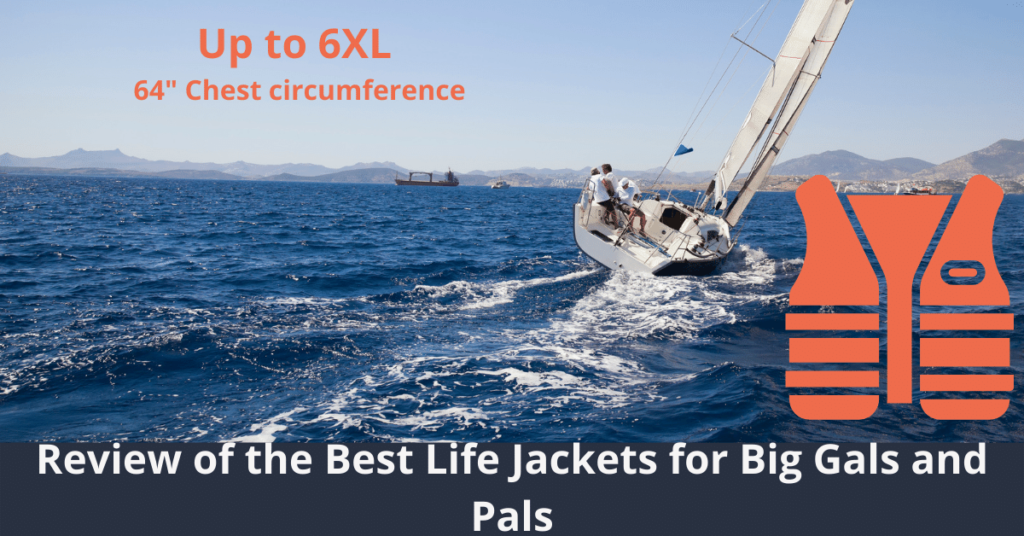







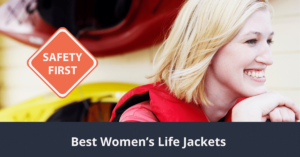
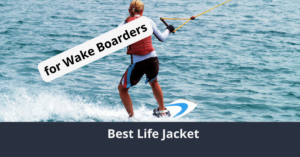
![7 Best Jet Ski Life Jackets with awesome fit [2023 guide] 12 Best Jet Ski Life Jacket](https://insmoothwaters.com/wp-content/uploads/2022/09/Best-Jet-Ski-Life-Jacket-300x157.png)
